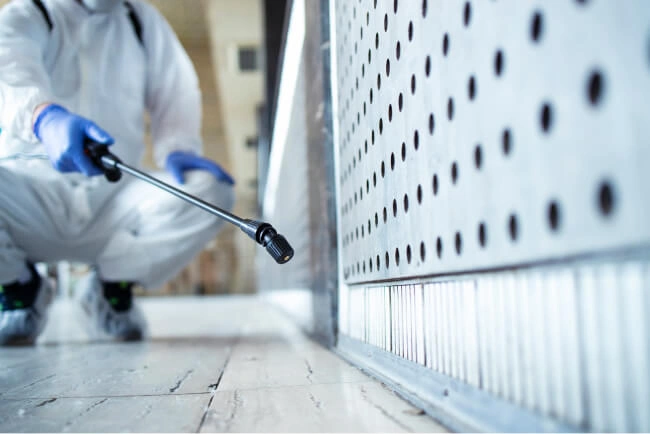
Professional Mold, Flood, and Toxic Cleanup Services
The team at Penn Jersey are well versed in dealing with difficult and potentially dangerous cleaning projects.
Often as one offs, but sometimes as ongoing cleaning services, we are able to create tailored, short notice cleaning strategies to deal with problems including damage, mold, flooding, lift shafts, spillages, and toxic substances. Penn Jersey’s team of experts will work with you to build an impact assessment and full cleaning strategy aimed at maximizing health and safety, cleaning requirements, while bringing all projects in on time and on budget.
We appreciate every cleanup situation is unique and often very distressing for the customer. We work with you to help put together a plan of action to remove any risky and hazardous residue such as mold, water or toxic substances. From there we can work to put together a cleanup plan and where necessary, strip the building back so restoration and redecoration work can begin. Our cleanup professionals have worked in many different environments dealing with a wide array of flooding, mold and toxic substance spillage situations.
Whatever the problem, we can assess and work with you to resolve it and ensure your premises is safe to rebuild and work on. Not all hazardous spillages, floods or mold growth situations are catastrophic and we can step in when you first find a problem too, ensuring it doesn’t take over and cause even more extensive damage to your business.
Hazardous Cleaning Services
We have listed a few of the dangerous cleaning services we provide. Standard cleaning teams are not equipped to deal with specialized situations, equipment, and hazardous substances. Our staff are fully trained to deal with each unique situation in order to provide the best outcome for you, the customer. Some of the situations we’ve encountered over the decades include:
Mold: Affordable mold clearance requires a detailed action plan, special equipment, and biohazard protection suits. At Penn Jersey we have dealt with serious mold outbreaks, returning working and living environments back to habitability. Living and working amongst mold is highly dangerous and at the first sight of any mold growth, it is important to bring in the professionals so it doesn’t become a bigger problem.
Floods: Whether long term or short term, water logging causes untold damage, often rendering furniture, items, and carpets useless. Our staff are fully trained to remove these and strip buildings back so they can be redecorated and returned to use. Water damage can be extensive but we work to strip your premises back as far as necessary to allow you to begin and rebuild.
Toxic Substances: A toxic spill requires the maximum health and safety training, skilled operatives, and the right equipment to safely remove substances and clean affected areas. We have decades of experience in working with and cleaning many different toxic substances. We work systematically to minimize damage and risk when removing any toxic substances.
Elevator Shafts: From time to time, elevator shafts need cleaning, which helps the machinery work better, maintains a healthy environment, and reduces the chances of accidents. We have the specialized staff and equipment to complete the task. Unclean elevator shafts can become a hazard in any business, so you need to consider cleaning services on a regular basis. Our experts can advise how often your shafts may need cleaning to ensure you never have to worry about them becoming a hazard.
Burnt Materials: Burnt materials can both include cleaning toxic and non-toxic substances left as a result of a fire, but also general damage as the result of fighting a fire. However, in such circumstances smoke damage may render the majority of furniture and fittings such as carpets unusable. We can, however, clean any fire damage which does not affect the integrity of the building. Our expert professional teams are able to assess and inform you what can and can’t be salvaged and will work sensitively to clean anything which can be maintained.
Hazardous Work Handled Safely
Sometimes a project comes up that involves toxic and hazardous material such as mold infestations as a result of flood damage, and other toxic materials. Penn Jersey's team has handled these for large institutions, and small properties alike. Our team are equipped with the latest safety equipment and are comfortable with handling the work safely and quickly.
How Much Should mold, Toxic and Flood Cleaning Cost?
Each cleaning project has its own unique requirements. This means we cannot put prices on our website or bundle them into packages. This is especially true of toxic, flood, and mold cleaning which result in varying degrees of damage, require different types of equipment and specially trained staff. These types of cleaning emergencies often come at short notice and require quick and effective responses. Penn Jersey Sales Consultants will talk you through our calculated costs for the project, item by item, explaining each point, so you will not get any surprises later on.
Emergency mold, Toxic, and Flood Cleaning?
No one plans to flood their commercial property or to spill toxic substances. Often the discovery of mold requires a quick solution. Penn Jersey are well versed in turning around dangerous spillages and contamination. We have the expertise and the experience to draw up quick turnaround plans to restore your premises to immaculate condition. We recognize almost all events of this kind are emergencies and will work quickly yet methodically to return your premises to its former self.
At Penn Jersey we utilize our decades of experience in every job we approach, even those which pose a new challenge. Mold infestations, toxic substance spillage and flood incidents are almost always unique but we have the professional experience and knowhow to step in and carry out a full and comprehensive cleanup. We know how to work safely around potentially harmful toxins and chemicals and ensure that they pose no risk to your or those around your property. We take safety extremely seriously and put it at the forefront of all we do in every hazardous situation, helping to ensure your premises is quickly restored to its best.
Retail Store Cleaning Services
Attention to detail from Penn Jersey’s experienced retail store cleaning team From busy high footfall stores to exclusive boutique retail premises, we deliver a retail cleaning solution to meet your requirements. We understand that success in retail is about maintaining...
Government Building Cleaning
Government buildings often require special permits, skills, and experience for restoration, decontamination and sanitation work. However, Penn Jersey has all the relevant skills, training, and equipment required to tackle most cleaning projects. Our comprehensive Government building cleaning services mean you...
Daycare Center Cleaning Services
After all, each day, parents entrust the care of their children to you. But you can rely on Penn Jersey to keep your childcare center safe and hygienic. With our 50 years of experience, we understand the specific nuances involved...
Let us work with you
Share your stories and insights to help us improve local businesses and residents' lives.


